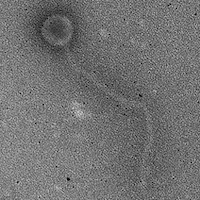Gordonia phage Magnus
Know something about this phage that we don't? Modify its data.
| Detailed Information for Phage Magnus | |
| Discovery Information | |
| Isolation Host | Gordonia terrae 3612 |
| Found By | Andrew O'Grady |
| Year Found | 2017 |
| Location Found | Pittsburgh (Oakland), PA USA |
| Finding Institution | University of Pittsburgh |
| Program | Science Education Alliance-Phage Hunters Advancing Genomics and Evolutionary Science |
| From enriched soil sample? | No |
| Isolation Temperature | Not entered |
| GPS Coordinates | 40.4431 N, 79.9547 W Map |
| Discovery Notes | Collected from outside William Pitt Union on the Forbes from the right hand flowerbed on 9-5-2017 at 8:05am. Weather: Temperature was 14.4C (58 F) and was humid outside the barometric pressure was 729.9 mmHg and the humidity was 79%. Soil Conditions: Sample was collected from underneath a layer of woodchips about 0.5 meters from a flower. Choose to collect moist bottom soil, rained the night before so soil was moist and dense. |
| Naming Notes | Name Magnus means strong and powerful. Magnus's lytic abilities make it a strong phage that effectively lyses host bacteria to reproduce. |
| Sequencing Information | |
| Sequencing Complete? | No |
| Genome length (bp) | Unknown |
| Character of genome ends | Unknown |
| Fasta file available? | No |
| Characterization | |
| Cluster | Unclustered |
| Subcluster | -- |
| Lysogeny Notes | Based on clear plaque morphology, Magnus is most likely a lytic phage. Lysogen testing should be performed to test the hypothesis. |
| Annotating Institution | Unknown or unassigned |
| Annotation Status | Not sequenced |
| Plaque Notes | Plaques were clear and varied between 0.5 and 0.75 mm in diameter. |
| Morphotype | Siphoviridae |
| Has been Phamerated? | No |
| Publication Info | |
| Uploaded to GenBank? | No |
| GenBank Accession | None yet |
| Refseq Number | None yet |
| Archiving Info | |
| Archiving status | Archived |
| SEA Lysate Titer | 2.0 x 10^10 pfu/mL |
| Pitt Freezer Box# | 57 |
| Pitt Freezer Box Grid# | F7 |
| Available Files | |
| Plaque Picture | Download |
| Restriction Digest Picture | Download |
| EM Picture | Download |

